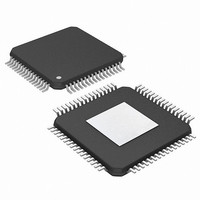PIC24FJ256DA210T-I/BG Microchip Technology, PIC24FJ256DA210T-I/BG Datasheet - Page 201

PIC24FJ256DA210T-I/BG
Manufacturer Part Number
PIC24FJ256DA210T-I/BG
Description
16-bit, 256KB Flash, 96K RAM, USB, Graphics 121 XBGA 10x10x1.20mm T/R
Manufacturer
Microchip Technology
Series
PIC® 24Fr
Specifications of PIC24FJ256DA210T-I/BG
Core Processor
PIC
Core Size
16-Bit
Speed
32MHz
Connectivity
I²C, IrDA, SPI, UART/USART, USB OTG
Peripherals
Brown-out Detect/Reset, GFX, LVD, POR, PWM, WDT
Number Of I /o
84
Program Memory Size
256KB (85.5K x 24)
Program Memory Type
FLASH
Ram Size
96K x 8
Voltage - Supply (vcc/vdd)
2.2 V ~ 3.6 V
Data Converters
A/D 24x10b
Oscillator Type
Internal
Operating Temperature
-40°C ~ 85°C
Package / Case
121-TFBGA
Lead Free Status / RoHS Status
Lead free / RoHS Compliant
Eeprom Size
-
Lead Free Status / RoHS Status
Lead free / RoHS Compliant
Available stocks
Company
Part Number
Manufacturer
Quantity
Price
Company:
Part Number:
PIC24FJ256DA210T-I/BG
Manufacturer:
Microchip Technology
Quantity:
10 000
- Current page: 201 of 408
- Download datasheet (4Mb)
14.0
Devices in the PIC24FJ256DA210 family feature all of
the 9 independent output compare modules. Each of
these modules offers a wide range of configuration and
operating options for generating pulse trains on internal
device events, and can produce pulse-width modulated
waveforms for driving power applications.
Key features of the output compare module include:
• Hardware configurable for 32-bit operation in all
• Synchronous and Trigger modes of output
• Two separate period registers (a main register,
• Configurable for single pulse or continuous pulse
• Up to 6 clock sources available for each module,
14.1
14.1.1
When the output compare module operates in a
free-running mode, the internal 16-bit counter,
OCxTMR, runs counts up continuously, wrapping
around from 0xFFFF to 0x0000 on each overflow, with
its period synchronized to the selected external clock
source. Compare or PWM events are generated each
time a match between the internal counter and one of
the period registers occurs.
2010 Microchip Technology Inc.
Note:
modes by cascading two adjacent modules
compare operation, with up to 31 user-selectable
trigger/sync sources available
OCxR, and a secondary register, OCxRS) for
greater flexibility in generating pulses of varying
widths
generation on an output event, or continuous
PWM waveform generation
driving a separate internal 16-bit counter
OUTPUT COMPARE WITH
DEDICATED TIMERS
General Operating Modes
This data sheet summarizes the features
of this group of PIC24F devices. It is not
intended to be a comprehensive reference
source. For more information, refer to the
“PIC24F
Section 35. “Output Compare with
Dedicated Timer” (DS39723). The infor-
mation in this data sheet supersedes the
information in the FRM.
SYNCHRONOUS AND TRIGGER
MODES
Family
Reference
Manual”,
PIC24FJ256DA210 FAMILY
In Synchronous mode, the module begins performing
its compare or PWM operation as soon as its selected
clock source is enabled. Whenever an event occurs on
the selected sync source, the module’s internal counter
is reset. In Trigger mode, the module waits for a sync
event from another internal module to occur before
allowing the counter to run.
Free-running mode is selected by default or any time
that the SYNCSEL bits (OCxCON2<4:0>) are set to
‘00000’. Synchronous or Trigger modes are selected
any time the SYNCSEL bits are set to any value except
‘00000’. The OCTRIG bit (OCxCON2<7>) selects
either Synchronous or Trigger mode; setting the bit
selects Trigger mode operation. In both modes, the
SYNCSEL bits determine the sync/trigger source.
14.1.2
By default, each module operates independently with
its own set of 16-bit timer and duty cycle registers. To
increase resolution, adjacent even and odd modules
can be configured to function as a single 32-bit module.
(For example, Modules 1 and 2 are paired, as are
Modules 3 and 4, and so on.) The odd numbered
module (OCx) provides the Least Significant 16 bits of
the 32-bit register pairs and the even module (OCy)
provides the Most Significant 16 bits. Wrap-arounds of
the OCx registers cause an increment of their
corresponding OCy registers.
Cascaded operation is configured in hardware by set-
ting the OC32 bit (OCxCON2<8>) for both modules.
For more details on cascading, refer to the “PIC24F
Family Reference Manual”, Section 35. “Output
Compare with Dedicated Timer”.
CASCADED (32-BIT) MODE
DS39969B-page 201
Related parts for PIC24FJ256DA210T-I/BG
Image
Part Number
Description
Manufacturer
Datasheet
Request
R

Part Number:
Description:
Manufacturer:
Microchip Technology Inc.
Datasheet:

Part Number:
Description:
Manufacturer:
Microchip Technology Inc.
Datasheet:

Part Number:
Description:
Manufacturer:
Microchip Technology Inc.
Datasheet:

Part Number:
Description:
Manufacturer:
Microchip Technology Inc.
Datasheet:

Part Number:
Description:
Manufacturer:
Microchip Technology Inc.
Datasheet:

Part Number:
Description:
Manufacturer:
Microchip Technology Inc.
Datasheet:

Part Number:
Description:
Manufacturer:
Microchip Technology Inc.
Datasheet:

Part Number:
Description:
Manufacturer:
Microchip Technology Inc.
Datasheet:











